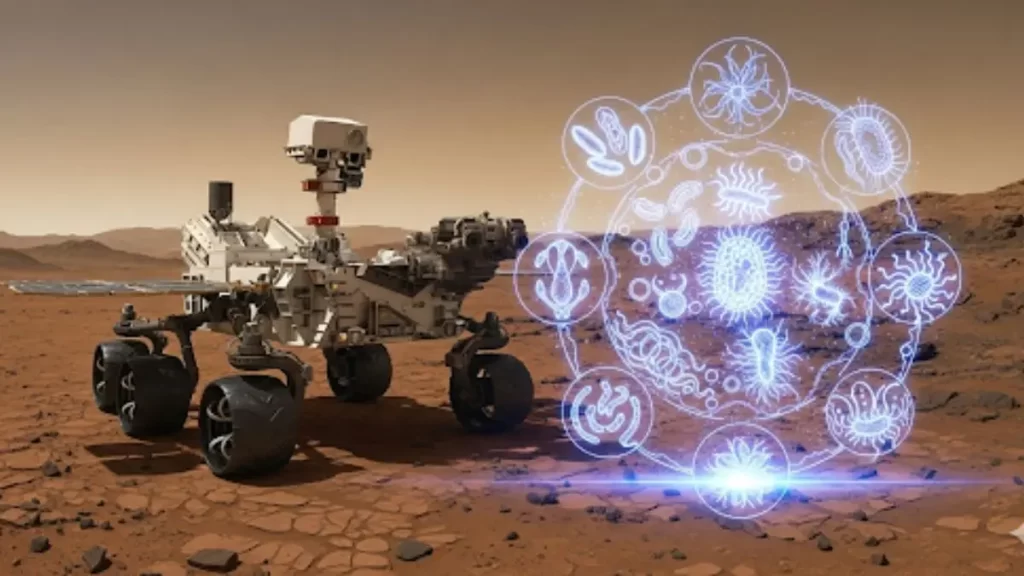NASA’s Mars Rover Uncovers the Strongest Clues Yet to Ancient Life on the Red Planet
Have you ever looked up at the night sky and wondered if we are alone in the universe? For years, scientists have dreamed about finding life beyond Earth. Now, NASA’s Perseverance rover has made a big step forward. It found rocks on Mars that show the strongest hints so far of ancient life. This news is exciting and could change how we think about our place in space. In this article, we will look at what the rover found, why it matters, and what comes next. Let’s dive in.
NASA Mars Rover Finds
What Did the Perseverance Rover Discover?
NASA’s Perseverance rover landed on Mars in 2021. Its job is to explore Jezero Crater, a place that was once full of water. Billions of years ago, rivers flowed there, and a big lake sat in the crater. Scientists think this spot is perfect for looking for signs of old life.
In the summer of 2024, the rover drove into Neretva Vallis, an old river channel. There, it found a special rock in the Bright Angel area. The rock is called Sapphire Canyon or Cheyava Falls in some reports. It looks like reddish mudstone, the kind of clay-rich rock that forms at the bottom of lakes. This rock has spots that look like leopard prints or tiny poppy seeds. These spots are full of iron phosphate and iron sulfide minerals, like vivianite and greigite.
Why are these minerals important? On Earth, they often form when tiny living things, like microbes, eat organic matter. The microbes change the chemicals around them, creating these minerals as waste. The rock also has organic carbon, which is the stuff life is made of. It’s like finding leftovers from an ancient meal that microbes might have eaten.
Joel Hurowitz, a scientist from Stony Brook University who led the study, said, “On Earth, reactions like these are often driven by the activity of microbes.” But he warns that we can’t be sure yet. There might be other ways these minerals formed without life. Maybe just chemicals mixing in water did it. Still, this is the best clue we have so far.
The discovery was shared in the journal Nature. It’s the 25th sample the rover has collected. Perseverance has now gathered 30 samples in total. These are stored in metal tubes, waiting to come back to Earth one day.
The Science: How Do We Know This Hints at Life?
Let’s break it down simply. Mars was not always the dry, red desert it is today. Long ago, it had rivers, lakes, and maybe even an ocean. Water is key for life as we know it. Jezero Crater shows signs of that wet past. The rover uses tools like cameras and lasers to study rocks.
In the Sapphire Canyon sample, the rover saw blue and green colors in the minerals. These colors come from chemical changes. On our planet, microbes in mud can cause the same thing. They take sulfate from the water and turn it into sulfide, making greigite. Vivianite forms when phosphate mixes with iron in a way that needs organic help.
Nicky Fox, NASA’s science mission chief, called it “the closest we’ve actually come to discovering ancient life on Mars.” She compared it to seeing fossils from a microbe’s meal. But scientists are careful. Janice Bishop and Mario Parente, who were not part of the study, said non-living processes could make the same spots. For example, hot water or volcanoes might do it.
To be sure, we need to check the samples in labs on Earth. The rover’s tools are good, but not perfect for spotting tiny signs of life. Hurowitz added, “We cannot rule those processes out completely on the basis of rover data alone.”
This find builds on past hints. Earlier, Perseverance found organic molecules and rocks shaped by water. But this one combines minerals, organics, and the right setting for life. It’s like putting puzzle pieces together.
Why This Discovery Matters: An Editorial View
As someone who follows space news, I think this is a game-changer. For decades, we’ve asked if life exists elsewhere. Finding even tiny ancient microbes on Mars would prove we’re not alone. It would mean life can start on other worlds, maybe even in our solar system.
Imagine what this means for us. It could inspire new generations to study science. Kids might dream of being astronauts or biologists on Mars. It also raises big questions. If life was on Mars, what happened to it? Did the planet dry up and kill everything? Could we bring life back or live there ourselves? NASA Mars Rover Finds
But let’s be real. This isn’t proof of little green men. It’s about microbes from billions of years ago. Still, it’s huge. In a world full of problems like climate change, this reminds us to look up. Space exploration unites people. NASA, with help from other countries, shows what we can do together.
Some might say it’s a waste of money. Why spend billions on rocks when we have issues on Earth? I disagree. These missions teach us about our own planet. Studying Mars’ past helps us understand climate and life here. Plus, the tech from rovers improves things like robots and batteries.
Skeptics are right to question. Science needs proof. But the excitement is real. Fox said it’s like “leftover fossils” from a microbe’s excretion. That’s gross but cool! It makes Mars feel alive, even if just in the past.
A Quick History of Mars Exploration
Mars has fascinated us for centuries. In the 1800s, people thought they saw canals on Mars, signs of smart beings. Telescopes got better, and we learned it’s cold and dry.
NASA started sending probes in the 1960s. Mariner 4 flew by in 1965, showing craters but no life. Vikings landed in 1976 and tested soil for microbes, but results were unclear.
In the 1990s, Pathfinder and Sojourner rover explored. Then came Spirit and Opportunity in 2004. They found signs of past water. Curiosity rover arrived in 2012 and confirmed Mars had lakes.
Perseverance is the latest. It not only looks for life but collects samples for return. China’s Tianwen-1 and UAE’s Hope are also studying Mars. It’s a global effort now.
This new find is the peak so far. Past missions gave hints, but Perseverance’s tools are smarter. It has a drill, helicopter buddy Ingenuity (now retired), and ways to spot chemicals.
Challenges and What Comes Next
Getting those samples home is tough. NASA’s Mars Sample Return plan costs about $11 billion. It was set for the 2030s, but now it might be the 2040s. Money issues and tech problems slow it down. Acting administrator Sean Duffy said all options are open, maybe even analyzing on Mars with better tools.
The rover left 10 tubes on the ground as backup. If we can’t pick them up soon, they wait safely.
In the meantime, scientists will study Earth rocks that look like Mars ones. They’ll test if non-life ways can make vivianite and greigite the same way.
Future missions could help. Europe and Japan plan to study Mars moons. NASA wants humans on Mars by the 2040s. Astronauts could dig deeper and find more clues.
Hurowitz hopes for “follow-on research” to test if biology made these features. Until samples return, we’ll use lab experiments.
Wrapping Up: A New Chapter in Space
NASA’s Perseverance rover has given us the strongest hints yet of ancient life on Mars. The Sapphire Canyon rock, with its minerals and organics, paints a picture of a wet, maybe living world long ago. While not proof, it’s a big leap.
In my view, this sparks hope. It shows science keeps pushing boundaries. Whether life was there or not, learning about Mars teaches us about life everywhere. Let’s keep exploring. Who knows what else is out there?
As we wait for more news, remember: The universe is vast, and we’re just starting to uncover its secrets. Stay tuned for updates on NASA’s Mars missions. If ancient life existed on the Red Planet, it changes everything.
NASA Mars Rover Finds



